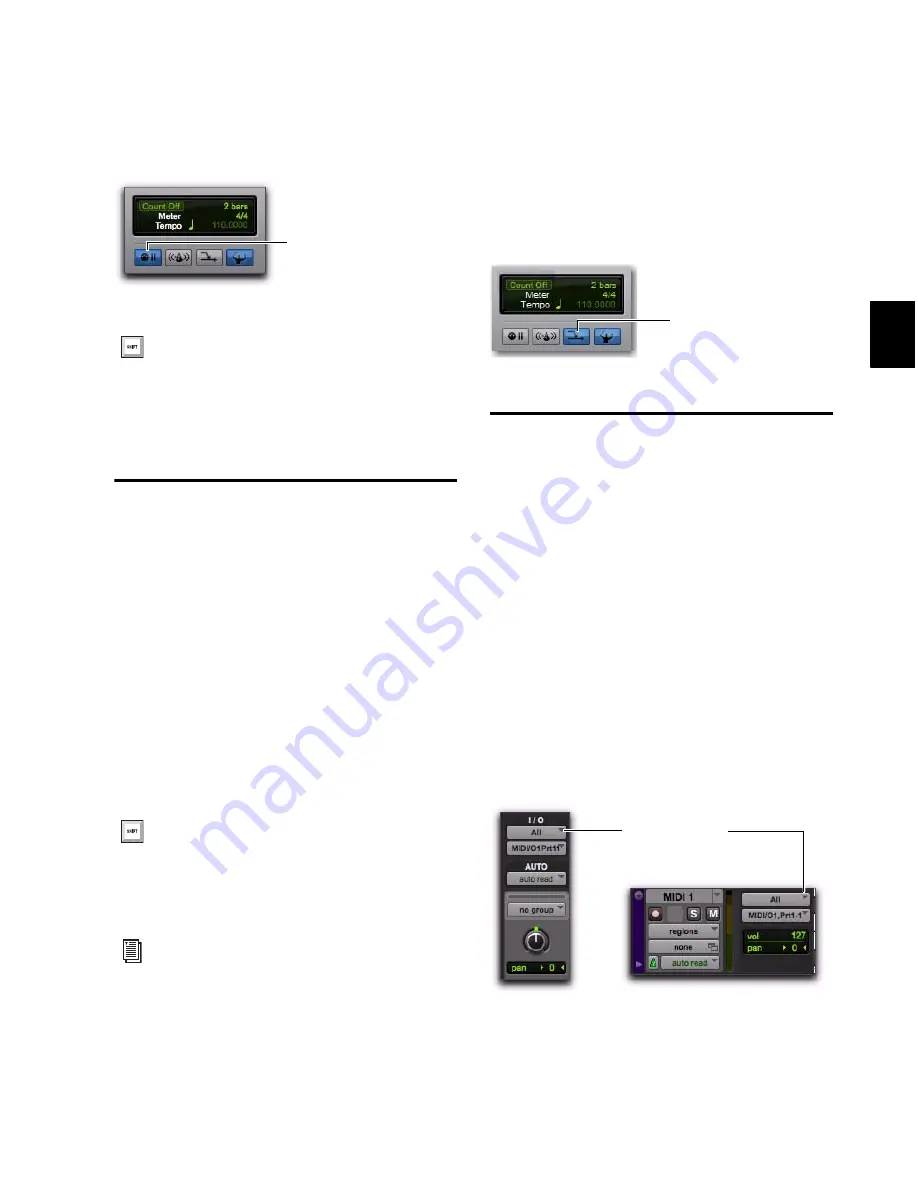
Chapter 20: MIDI Recording
393
2
In the Transport window, click the Wait for
Note button so it becomes highlighted.
MIDI Merge/Replace
The MIDI Merge button, located in the Trans-
port window, determines how MIDI is recorded
when overdubbing or punching in. When MIDI
Merge is on (
Merge
mode), recorded MIDI is
merged with existing track material. When
MIDI Merge is off (
Replace
mode), existing data
within the punched region is replaced by the
newly recorded material.
The MIDI Merge button can be turned on and
off during playback and recording. In Loop
Record mode, MIDI Merge has no effect, and the
button is dimmed.
To enable MIDI Merge:
1
To view the MIDI controls in the Transport
window, select
View > Transport > MIDI Controls
.
2
In the Transport window, click the MIDI
Merge button so it becomes highlighted.
Configuring MIDI or
Instrument Tracks for
Recording
To configure one or more MIDI or Instrument
tracks for recording:
1
Create a new MIDI or Instrument track, or use
an existing MIDI or Instrument track.
2
For Instrument tracks, select
View > Mix
Window > Instruments
or
View > Edit Window >
Instruments
.
3
From the track’s MIDI Input selector, select the
device and channel to be recorded. (For Instru-
ment tracks, the MIDI Input selector is available
in Instruments view.)
Wait for Note enabled
With the Operation preference for “Use F11
for Wait for Note” enabled, you can press
F11 to turn on Wait for Note. (On Mac sys-
tems, the Mac “Desktop” keyboard shortcut
must be disabled or remapped.)
To enable MIDI Merge with a keyboard
shortcut, set the Numeric Keypad mode to
Transport, and press the 9 key on the nu-
meric keypad.
You can also paste and merge MIDI notes
using Paste Special commands. See “Special
Paste Function for Automation Data” on
page 935.
Wait for Note button
MIDI Merge enabled
MIDI track Input selector
MIDI Merge button
MIDI Input selector
Summary of Contents for Digidesign Pro Tools 8.0
Page 1: ...Reference Guide Pro Tools 8 0 ...
Page 18: ...Pro Tools Reference Guide xviii ...
Page 19: ...1 Part I Introduction ...
Page 20: ...2 ...
Page 24: ...Pro Tools Reference Guide 6 ...
Page 40: ...Pro Tools Reference Guide 22 ...
Page 45: ...27 Part II System Configuration ...
Page 46: ...28 ...
Page 58: ...Pro Tools Reference Guide 40 ...
Page 76: ...Pro Tools Reference Guide 58 ...
Page 118: ...Pro Tools Reference Guide 100 ...
Page 127: ...109 Part III Sessions Tracks ...
Page 128: ...110 ...
Page 144: ...Pro Tools Reference Guide 126 ...
Page 170: ...Pro Tools Reference Guide 152 ...
Page 228: ...Pro Tools Reference Guide 210 ...
Page 292: ...Pro Tools Reference Guide 274 ...
Page 343: ...325 Part IV Playback and Recording ...
Page 344: ...326 ...
Page 386: ...Pro Tools Reference Guide 368 ...
Page 442: ...Pro Tools Reference Guide 424 ...
Page 443: ...425 Part V Editing ...
Page 444: ...426 ...
Page 490: ...Pro Tools Reference Guide 472 ...
Page 528: ...Pro Tools Reference Guide 510 ...
Page 566: ...Pro Tools Reference Guide 548 ...
Page 590: ...Pro Tools Reference Guide 572 ...
Page 591: ...573 Part VI MIDI ...
Page 592: ...574 ...
Page 648: ...Pro Tools Reference Guide 630 ...
Page 670: ...Pro Tools Reference Guide 652 ...
Page 679: ...661 Part VII Arranging ...
Page 680: ...662 ...
Page 756: ...Pro Tools Reference Guide 738 ...
Page 769: ...751 Part VIII Processing ...
Page 770: ...752 ...
Page 780: ...Pro Tools Reference Guide 762 ...
Page 786: ...Pro Tools Reference Guide 768 Figure 3 Quantized audio events Warp markers in Warp view ...
Page 814: ...Pro Tools Reference Guide 796 ...
Page 842: ...Pro Tools Reference Guide 824 ...
Page 843: ...825 Part IX Mixing ...
Page 844: ...826 ...
Page 976: ...Pro Tools Reference Guide 958 ...
Page 991: ...973 Part X Surround ...
Page 992: ...974 ...
Page 1000: ...Pro Tools Reference Guide 982 ...
Page 1025: ...1007 Part XI Sync and Video ...
Page 1026: ...1008 ...
Page 1080: ...Pro Tools Reference Guide 1062 ...
Page 1111: ......






























